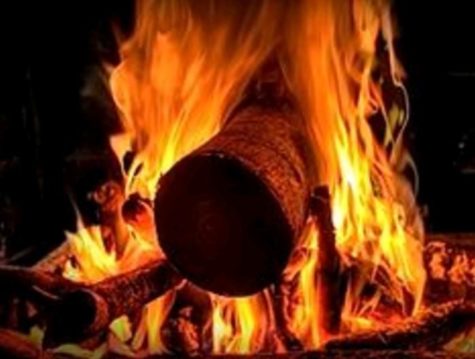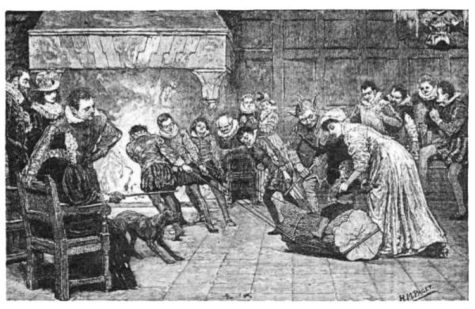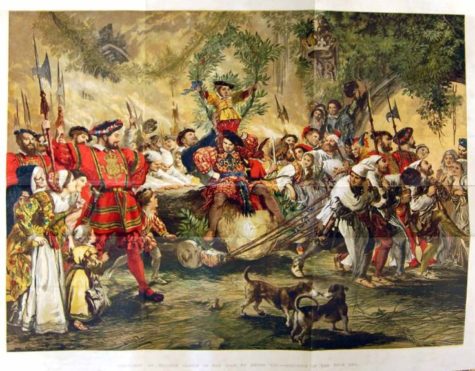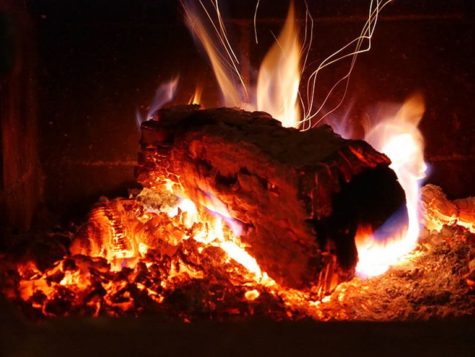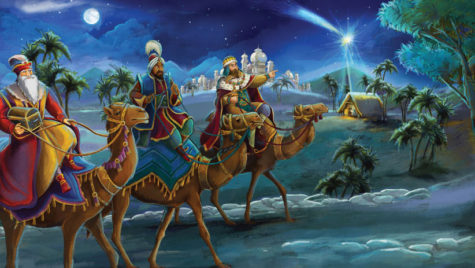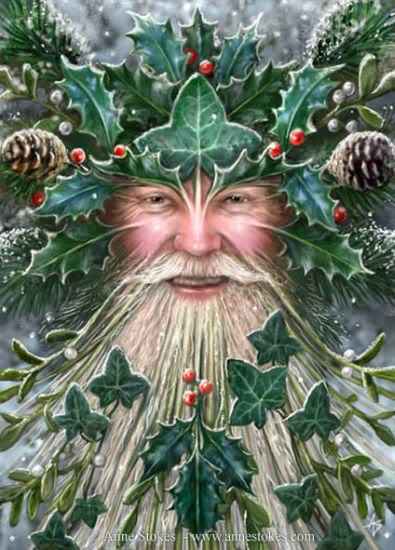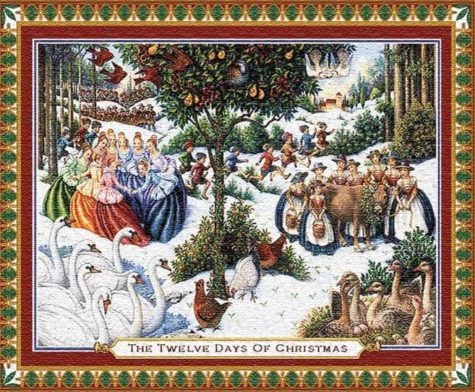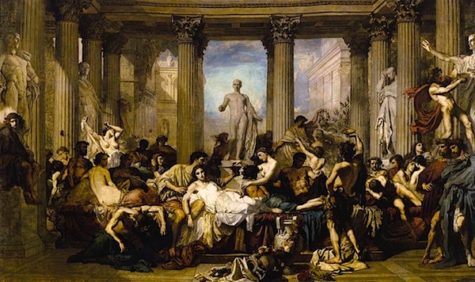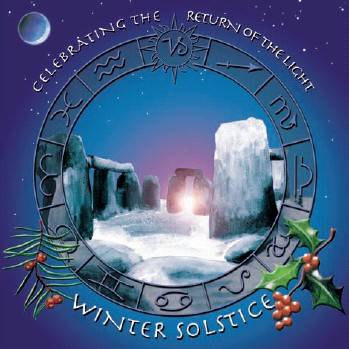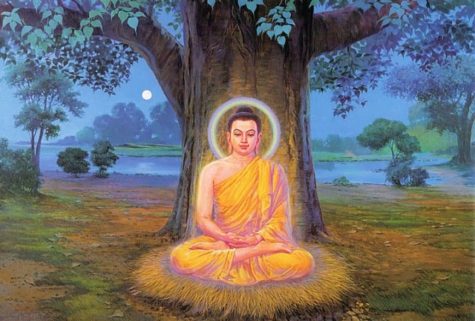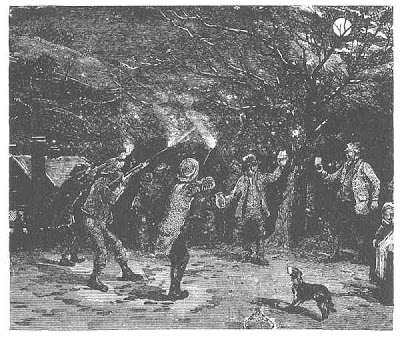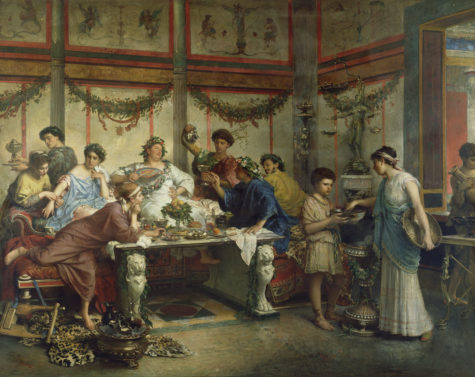Midwinter Festivals
On the winter solstice, on the longest night of the year, people would place and set afire an entire tree, that was carefully chosen and brought into the house with great ceremony. The largest end of the log would be placed into the fire hearth while the rest of the tree stuck out into the room! The log would be lit from the remains of the previous year’s log which had been carefully stored away and slowly fed into the fire through the Twelve Days of Christmas.
It was considered important that the re-lighting process was carried out by someone with clean hands.
Tradition has it that the burning of the Yule log was performed to honor the Great Mother Goddess. The log would be lit on the eve of the solstice using the remains of the log from the previous year and would be burned for twelve hours for good luck and protection.
As the fire began all other lights would be extinguished and the people would gather round the fire. In thanksgiving and appreciation for the events of the past year and in bidding the year farewell each person would toss dried holly twigs into the fire.
The next phase of the burning of the Yule log commenced with people tossing oak twigs and acorns into the fire and they would shout out their hopes and resolutions for the coming New Year and sing Yuletide carols. The celebration of the Yule log fire ended with unburned pieces of the Yule log saved to start the fire of next winter’s solstice Yule log.
The custom of the Yule Log spread all over Europe and different kids of wood are used in different countries. In England, Oak is traditional. The “mighty oak” was the most sacred tree of Europe, representing the waxing sun, symbolized endurance, strength, protection, and good luck to people in the coming year. In Scotland, it is Birch; while in France, it’s Cherry. Also, in France, the log is sprinkled with wine, before it is burnt, so that it smells nice when it is lit.
The earliest Yule Log in France can be traced back to Celtic Brittany. When the Catholic Church stamped out the Pagan tradition, it adapted. In the 12th century, the ceremony became more elaborate.
Families would haul home enormous logs and in some regions, the youngest child was allowed to ride the log home. As families dragged their logs home, passers by would raise their hats because they knew the log was full of good promises and its flame would burn out old wrongs.
For the Vikings, the yule log was an integral part of their celebration of the solstice, the julfest; on the log, they would carve runes representing unwanted traits (such as ill fortune or poor honor) that they wanted the gods to take from them.
People would also use the log as a way to predict events in the upcoming year. They would hit the burning log with tongs and the embers emitted would tell them what the harvest would be like. The more embers, the more corn. The fire was read and predictions were made for the coming year based on the sparks and flames they saw, like how many chickens or calves would be born, marriages in the family, health, wealth, etc. If the fire cast shadows on the wall, there would be a death in the family that year.
The remaining cinders would be placed in the soil so they would prevent grain diseases and produce a good harvest. They’d be spread around chicken coops to keep away foxes and in the barns and lofts where corn was stored to keep rats and weevils away. During a storm, throwing a handful into the fire would keep the house safe from lightening.
The ashes of the Yule Log were believed to hold magical and medicinal powers that would ward off evil spirits for the coming year. Ashes from the Yule log are very beneficial to garden plants, however, it is considered very unlucky to throw out the ashes of the Yule log on Christmas day.
Various chemicals can be sprinkled on the log like wine to make the log burn with different colored flames! Here’s a short list. Be sure to follow safety precautions if you plan on using them!!
- Potassium Nitrate = Violet
- Barium Nitrate = Apple Green
- Borax = Vivid Green
- Copper Sulphate = Blue
- Table Salt = Bright Yellow
Santa Claus may have gone back to the North Pole to rest, but it doesn’t mean the gift-giving (and receiving) is over — at least not for the thousands of children in Latin America and Spain anxiously awaiting“El Día de los Reyes” Celebration on Jan. 6th.
- Children leave their shoes right outside their doors so the Three Kings will leave their gifts inside, the bigger presents are placed around them.
- Many families leave a box of grass (or hay) and water for The Three King’s camels to eat. Similar to the tradition of leaving out cookies and milk for Santa Claus. Camels are known for being a bit sloppy and leaving a trail of hay behind that children can often follow to their gifts!
- Hispanic families will usually celebrate Three Kings Day with a scrumptious dinner that is topped off with the King’s Bread (Rosca de Reyes) for dessert. Children also sometimes make crowns to wear at the table in honor of the kings.
For many Christians, the holiday season doesn’t officially end until the 12th day of Christmas known as the “Feast of the Epiphany” or “Three Kings’ Day”.
The holiday marks the biblical adoration of baby Jesus by the three Kings, also referred to as three Wise Men or Magi. According to the Gospel of Matthew, the men found the divine child by following a star across the desert for twelve days to Bethlehem. Melchior, Caspar, and Balthazar — representing Europe, Arabia, and Africa respectively — traveled by horse, camel, and elephant in order to present baby Jesus with three symbolic gifts.
- Gold
- Frankincense
- Myrrh
The gold offered by one of the wise men is a symbolic acknowledgment of Jesus’ royal standing as “King of the Jews,” while the frankincense manifests the divine nature of the baby’s existence, since he is not an earthly king but the Son of God. And finally the myrrh, often used to embalm corpses, was gifted to the newborn as a symbol of Jesus’ mortality — foreshadowing his death as a means to cleanse humanity of its sins.
Reyes festivities come in different shapes and sizes across the globe from community parades to three-day celebrations at Disneyland. In Mexico, thousands gather every year to taste a mile-long “Rosca de Reyes” (Kings’ Bread) while others simply make the holiday staple at home honoring the tradition to hide a baby Jesus figurine within the bread — the person whose slice has the figurine must prepare tamales for everyone on the Day of the Candles on Feb. 2!
Source: Huffington Post
In Italian folklore, Befana is an old woman who delivers gifts to children throughout Italy on Epiphany Eve (the night of January 5) in a similar way to St Nicholas or Santa Claus.
In popular folklore Befana visits all the children of Italy on the eve of the Feast of the Epiphany to fill their socks with candy and presents if they are good, or a lump of coal or dark candy if they are bad. In many poorer parts of Italy and in particular rural Sicily, a stick in a stocking was placed instead of coal. Being a good housekeeper, many say she will sweep the floor before she leaves. To some the sweeping meant the sweeping away of the problems of the year. The child’s family typically leaves a small glass of wine and a plate with a few morsels of food, often regional or local, for the Befana.
Befana is invoked in many Italian spells, especially those for good fortune. She brings sweets for children but may be persuaded to bring the sweetness of life to adults as well.
- On Epiphany Eve, write her a note expressing your desires.
- Place it beneath a red witch-shaped candle and burn.
- Accompany with offerings.
She is usually portrayed as a hag riding a broomstick through the air wearing a black shawl and is covered in soot because she enters the children’s houses through the chimney. She is often smiling and carries a bag or hamper filled with candy, gifts, or both. Popular tradition tells that if one sees La Befana one will receive a thump from her broomstick, as she doesn’t wish to be seen. This aspect of the tradition may be designed to keep children in their beds.
She is also referred to as the Christmas Witch. Continue reading
Also known as Mithras (for the Persian Sun God), Saturnalia (for the Roman God of sowing and husbandry) and The Great Day of the Cauldron (from Druid Legend). It is the celebration of the return, or rebirth, of the Sun God, the Lord of Life. The celebrations were traditionally performed with the utmost solemnity, yet also with the highest rejoicing, for they resolve the paradox of Death and Rebirth. It represents the redemption of the world from Death and Darkness, as such it is a celebration of hope and joy amidst the gloom of winter.
The word Yule can be traced to the Celtic word `Hioul” which means wheel. This festival is an important point in the turning of the wheel of the year. Wreaths were made to symbolize this wheel, combining solar significance with tree-god significance. In ancient times Celts venerated trees as earthly representatives of the Gods, and it was felt that nothing short of the sacrifice of a mighty tree-god would cause the receding sun to take pity on them and return.
The burning of the Yule log was thought, through sympathetic magick, to increase the brightness and strength of the Sun, and would therefore bring good luck. Passersby would tip their hat or nod in salutation to the log. It is traditional to cut the log from oak or from a slow-burning fruit tree. The fire was lit from a piece of the previous years Yule log, which had been saved for this purpose. It was believed that this piece of the old log was a charm against fire, because it would refuse to burn until it was time to light its successor. A wish was also made while pouring wine over the burning log. It was believed to be bad luck if the log burned out before the 12 days of Yuletide were over. The ashes from the fire were spread in the fields to bring fertility to the next crop.
The Wassail bowl is another favored part of Yule celebrations. A large bowl or pot was filled with wassail, a mixture of cider and spices, and warmed over the Yule fire. The meaning of the word wassail is to be `hale or hearty’, and was the reason for the many toasts and salutations made from the bowl. It was also common for a procession to go to the nearest orchard and wassail the trees, thus blessing them and encouraging them to bear a good yield in the coming season. Libations of wassail were also poured over the roots of the trees, and cider drenched cakes were left in the forks of the older trees as an offering to the trees spirit.
Mistletoe is a regeneration symbol, considered to be the Essence of Life due to the resemblance of the juice of the berries to male semen. It was often gathered at this time. Evergreen boughs are also symbols of renewal. Evergreens were decorated to show honor to the tree spirits. The lights on modern trees were the candles of old, and represent the newly born sun god. Trees were not cut down and brought indoors.
The Sacred Seed of Life, having been nurtured by the foster mother Tailltiu, sprang forth from her breast, and was born. As the Wyrrd had foretold, here was the Child of Promise, son of the Gods and of the Earth. This baby was the Sun God, born in the Rule of Darkness, by the magick of the Gods. He was destined to grow in strength and knowledge. It was his task to bring back life and warmth to the land, and to wrest the power from the Lord of Darkness. To appease Cernunnos, who is at the peak of his strength, the people made sacrifices of roasted boar. To distract Callieach, the Wise Ones, or Witches invoked her to teach them of her mysteries. To aid the new-born Sun God the Celts felled a giant oak tree, and burned the log as a sacrifice, that the sun would gain strength from it, and grow.
Despite the powers of Cernunnos and Cailleach, the signs of new life were still upon the land. The sacred seeds which had fallen onto the barren branches of the winter-dead trees had come to life, and thus became the Mistletoe, which could be seen hanging from the oaks in the forests. Upon the land these sacred seeds had grown into the sweet smelling evergreens, and thus they were decreed to be a part of the celebration.
In honor of this magickal birth the people decorated the evergreens with candles and other symbols of life. The Druids told of Hu-Gadarn, the first druid, who had fled from the Atlalntean flood with his family on this day on the Ark, “The Great Cauldron” in which they brought the Essence of Life, and the knowledge of magick into the world. They would also tell tales of the Killing of the Wren, and of the Battle between the Oak King and the Holly King. Throughout the land the people rejoiced, and there was light in the midst of the darkness.
Blessed Be
~Lady Galadriel
From the earliest times the twelve days have been regarded as a time when supernatural events can easily happen, when the dead are close at hand and might often be seen.
One reads of the Wild Hunt, or the Fairy Host riding across the lands of Britain and Germany in particular, led by characters such as King Arthur, Woden, and Arawn, the Celtic god of the Underworld. In Ireland these supernatural hunters are known as the Yule Host, and in common with all these bands they are believed to gather up wandering souls and carry them away to the Otherworld.
The Twelve Days of Christmas stand outside of “ordinary time,” and celebrations focus on the return of the sun and a continuation of the eternal cycle of life.
The days from Christmas Eve on December 24th to Epiphany on the 6th of January (actually fourteen days as the first and last are not included in the twelve) really exist out of linear time. They are, in a sense, the fruit of the past year, one day for each month that has passed. Over the centuries the dates have changed – sometimes radically.
Here’s a list of commonly accepted dates and traditions:
- Day 0 – Dec 24 – Christmas Eve
- Day 1 – Dec 25 – Christmas Day, Birthday of Jesus, Mithras, Attis, Aion, Horus, Dionysus, and The Unconquered Sun.
- Day 2 – Dec 26 – St Stephen’s Day, Boxing Day, Day of the Wren
- Day 3 – Dec 27 – Mother Night, St John’s Day
- Day 4 – Dec 28 – Holy Innocent’s Day, Childremass, Dyzymas Day
- Day 5 – Dec 29 – Feast of Fools
- Day 6 – Dec 30 – Bringing in the Boar
- Day 7 – Dec 31 – New Year’s Eve, Hogmanay
- Day 8 – Jan 1 – New Year’s Day,
- Day 9 – Jan 2 – The Kalends of January
- Day 10: – Jan 3 – Snow Day
- Day 11 – Jan 4 – Evergreen Day
- Day 12 – Jan 5 – Twelfth Night
- Day 13 – Jan 6 – Epiphany,
When researching lore and magicks for the Twelve Days of Christmas I found a lot of disagreement as to the dates. So, from Wikipedia we have this explanation and additional information:
The Twelve Days of Christmas are the festive days beginning Christmas Day (25 December). This period is also known as Christmastide and Twelvetide. The Twelfth Night of Christmas is always on the evening of 5 January, but the Twelfth Day can either precede or follow the Twelfth Night according to which Christian tradition is followed. Twelfth Night is followed by the Feast of the Epiphany on 6 January. In some traditions, the first day of Epiphany (6 January) and the twelfth day of Christmas overlap.
Over the centuries, differing churches and sects of Christianity have changed the actual traditions, time frame and their interpretations. St. Stephen’s Day (or Boxing Day), for example, is 26 December in the Western Church and 27 December in the Eastern Church.Boxing Day, on December 26, is observed as a legal holiday in parts of the Commonwealth of Nations. 28 December is Childermas or the Feast of the Innocents.
Currently, the twelve days and nights are celebrated in widely varying ways around the world. For example, some give gifts only on Christmas Day, some only on Twelfth Night, and some each of the twelve nights.
In England in the Middle Ages, this period was one of continuous feasting and merrymaking, which climaxed on Twelfth Night, the traditional end of the Christmas season. Continue reading
Saturnalia was an ancient Roman festival in honor of the deity Saturn. Originally it was held on 17 December of the Julian Calendar, but the party later expanded with festivities through to 23 December. The poet Catullus called it “the best of days”.
Saturn being an ancient national god of Latium, the institution of the Saturnalia is lost in the most remote antiquity. In Roman mythology, Saturn was an agricultural deity who was said to have reigned over the world in the Golden Age, when humans enjoyed the spontaneous bounty of the earth without labor in a state of innocence. The revelries of Saturnalia were supposed to reflect the conditions of the lost mythical age, not all of them desirable. The Greek equivalent was the Kronia.
Falling towards the end of December, at the season when the agricultural labors of the year were completed, it was celebrated by the country-people as a sort of joyous harvest home, and in every age was viewed by all classes of the community as a period of absolute relaxation and unrestrained merriment. The festival was extended in later times to three and still later to seven days.
During the celebration of this holiday no public business could be transacted, the courts were closed, war was suspended, all private enmities were for the time forgotten, and the city was alive with hilarity. On this day the slaves feasted and were waited upon by their masters, as the female slaves were waited upon by their mistresses on the Matronalia.
The special feature of the festival was the gift of wax candles and of little images of wax or clay called sigilla. The public festival, in the time of the republic, was for only one day; but for seven days the celebration continued in private houses.
Many of the customs of the Roman Saturnalia were taken over by the Christian Church in celebrating Christmas. Thus the origin of the Christmas-tree, and the custom of making presents to children and friends may be traced back to the Roman Saturnalia, while the Yule-log and Yule-fire are remnants of ancient sun-worship, one of the Roman festivals in honor of the Sun god being celebrated on the 25th of December as “Dies Natalis Solis Invicti.”
Although probably the best-known Roman holiday, Saturnalia as a whole is not described from beginning to end in any single ancient source. Modern understanding of the festival is pieced together from several accounts dealing with various aspects.
Here’s some History:
Saturnalia festivities began with ritual and sacrifices in the Temple of Saturn. The statue of the god was hollow and filled with olive oil, as a symbol of his agricultural functions. His feet were bound with woolen strips, that were unbound at Saturnalia.
After the rituals, the Senators (who had to be present) dismissed the crowd with the cry of “Io, Saturnalia!”, a sign for the happy festivities of family parties and other private gatherings to begin. The traditional gifts were wax tapers and little dolls, although gifts of silver later became traditional.
The custom of the Lord of Misrule was appropriated and survived through to English Christmas traditions.
The biggest part of Saturnalia was attitude more than decoration. Feasting, drunkenness, merrymaking, hopefully the conception of more children (or at least enjoying those activities which led to conception!), pranks, gift giving, role reversals (not true ones, only symbolic ones – slaves weren’t really free to make a freedman’s decisions and anything they did or decreed would reverse at the end of Saturnalia, children weren’t really adults and could not enter into any binding contracts or make business deals, etc.) and so forth.
The role reversals seemed to be more for minor privileges – slaves and children got to be waited on for meals, and to lead the rituals, and to participate in the revelry as if they were their parents/masters. The parents/masters jokingly played the part of slaves and children by waiting on them and making rude and bawdy jokes at their expense. Sometimes, it descended into cruelty.
Many of the decorations involved greenery – swathes, garlands, wreaths, etc – being hung over doorways and windows, and ornamenting stairs. Ornaments in the trees included sun symbols, stars, and faces of the God Janus. Trees were not brought indoors (the Germans started that tradition), but decorated where they grew.
Food was also a primary decoration – gilded cakes in a variety of shapes were quite popular, and children and birds vied for the privilege of denuding the trees of their treats. The commonest shapes were fertility symbols, suns and moons and stars, baby shapes, and herd animal shapes (although, to be honest, it’s hard to tell if some of those ancient cookie cutters are supposed to be goats or deer). I would imagine coins were also a popular decoration/gift.
People were just as likely to be ornamented as the trees. Wearing greenery and jewelry of a sacred nature was apparently common, based on descriptions, drawings, and the like from the era. Although the emphasis was on Saturn, Sol Invictus got a fair share of the revelry as well.
On a modern note:
This ancient midwinter festival falls at the time when non-Romans are celebrating Christmas, Hanukkah, Solstice and/or Kwanzaa. In Nova Roma, individual Citizens have chosen different approaches to the challenge of celebrating in the spirit of Rome without cutting themselves off from the culture in which they live.
Gold, because the sun is yellow, is always a sure choice for a good Saturnalia decoration. For modern Saturnalia, those golden glass ball ornaments are ideal, as are gold sun faces, gold stars, and gilded anythings. Gilding nuts and pine cones and nestling them among the swags and wreaths of greenery would be a lovely way of acknowledging the ancient roots of this ceremony.
Indoor trees are not ancient Roman, but if you have plants growing indoors, decorating them would certainly be in the spirit of the holidays. If you just have to have the now-traditional indoor tree, try decorating it in gold ornaments with a solar theme. Swathe it in bright red or purple ribbons (2 colors quite in favor with the Romans, and looks great with the gold ornaments). Top the tree with a sun, rather than a star, for after all, this is a solar celebration.
Wild parties with lots of food and drink is good. Letting the children of the household lead the common rituals, and waiting on them (assuming you don’t do so in everyday circumstances….) at mealtimes, and deferring to them in decisions on party ideas would work for role reversals.
No children in the house? Maybe you can borrow one for a day. We don’t have slaves, but, for a nice touch of role reversal, we could purchase the services of a nanny or a housekeeper for the duration of Saturnalia. It would be a role reversal of sorts, for instead of being the slave of your home, someone else would be doing the chores and cooking and childcare while you got to party down!
Dancing and singing in the streets is now frowned upon, unless you can get a parade permit. A parade, if you could organize it, would be fun. Imagine – giant floats of the Gods tended by the priests and acolytes, musicians and dancers, contortionists to amaze and delight, acrobats and jugglers, all in honor of Saturn!
For a compilation of Saturnalia celebrations reported by Nova Romans, visit Saturnalia practices of Nova Romans.
Here is a nice little article about the history of midwinter celebrations from Delaware Online:
Ancient Worship:
Long ago, people worshiped the sun as a god. His cycles were watched and measured with great care because it was thought the quality of life on Earth changed dramatically according to his whims.
As the season changed and winter fell, survival became much harder for ancient man. Many would not live through a cold winter, when food became scarce. As the days shortened, they feared the sun would disappear completely and leave them helpless in the dark.
So they lighted fires and performed elaborate rituals to ensure the sun’s return. They also feasted when the sun reversed its course, and days began to grow long again.
One of the earliest solstice celebrations was the Mesopotamian holiday Zagmuk. When light waned in mid-winter, Mesopotamians would re-enact their god Marduk’s battle against the forces of darkness and chaos and then celebrate the victory of light and order.
More than 4,000 years ago, ancient Egyptians called their sun god Ra-Horakhty, later known as Horus. As winter arrived and his appearance became more brief each day, it was seen as a sign that he was growing weak and ill. In late December, when days began to grow longer, they celebrated his recovery and renewed health. They decked their homes with palm fronds, which symbolized the victory of life over death.
Romans honored the god Saturn by celebrating Saturnalia in early December. This festival was followed, on the solstice, by Brumalia, from the word bruma meaning “shortest day.”
By 70 A.D., many Roman soldiers had joined a cult around the sun god Mithras, whom they adopted after fighting in Persia, modern day Iran and Syria. Dec. 25 was recognized as Mithras’ birthday.
Because Mithras was so popular with soldiers, his cult spread quickly to all parts of the Roman Empire, Turkey, Bulgaria, Romania, the Balkans and gained a strong foothold in Britain. His temples, called Mithraeums, can be found throughout England and Germany.
In the fourth century, the Roman Emperor Constantine proclaimed Dec. 25 the birthday of Jesus Christ, according to many scholars.
“The popularity of Mithraism in the Roman Empire was probably why the early Christian Church decided to celebrate the birth of Jesus at that time,” said Alan Fox, a philosophy professor at the University of Delaware. It was thought that it would be easier to persuade the local people to accept new beliefs if the new religious rituals were superimposed on a holiday from their own religion.
Our Christmas celebrations closely resemble the ancient Roman festivals. People went visiting, gifts were exchanged and feasts were shared. Decorated cookies and cakes were baked and given out to friends. Trees were hung with pieces of metal, and homes were lighted with candles and festooned with holly and other greenery, often in the form of wreaths.
Modern ritual:
As their earliest ancestors did, many Delawareans will celebrate the shortest day of the year, Dec. 21, with reflection and celebration.
Ivo Dominguez Jr. plans to mark the event outside his rural Georgetown home with a bonfire and rituals that symbolize new light and life. Under the night sky, Dominguez, an elder in a religious community known as the Assembly of the Sacred Wheel, will gather with more than 50 fellow Wiccans.
Wicca, a nature religion whose central deity is a mother goddess, is one of the nation’s fastest-growing spiritual traditions, according to the American Academy of Religion. It was formally founded in the United Kingdom in the late 1940s.
To Dominguez and other practitioners, the fascination with the cycles of nature goes back tens of thousands of years. And for people atuned to the Earth and the sun, the winter solstice is an important time.
“It’s a time to gather and renew hope,” Dominguez said.
Many spiritual traditions also have rituals of light at what is also the season of greatest dark.
Judaism has Hanukkah, a festival of lights. And Christians have numerous traditions, including the lighting of a Christmas tree. An annual celebration that remains popular in Delaware’s Swedish community is the St. Lucia Festival.
Because St. Lucia’s name means light, she was known as the saint of light in Norway and Sweden and was considered responsible for turning the tide of long winter days and bringing back the sun.
This year, about 300 people gathered Sunday at the Old Swedes Episcopal Church in Wilmington to watch the pageant. It begins with a procession led by a young girl chosen to represent St. Lucia.
During the pageant, St. Lucia wears a crown of candles, and her attendants wear white gowns with red sashes to symbolize Lucia’s bloody death by sword. She was said to have been beheaded in the year 304 during Christian persecutions in Sicily. St. Lucia’s feast day (the day of her martyrdom) falls on Dec. 13, which, by the Julian calendar, was also the solstice. In 1300, with the change to the Gregorian calendar, the solstice came to fall on Dec. 21.
“The festival of St. Lucia is very important in Sweden because they have a lot of darkness.” said Jo Thompson, a spokeswoman for the Old Swedes church. “The solstice was a signal that spring is coming.”
At Mill Creek Unitarian Universalist Church, an outdoor gathering will help participants connect with nature, said church minister Nancy Dean. The church will celebrate the solstice at 7:30 p.m. Wednesday with a bonfire and service.
“Winter was always a difficult time,” Dean said. “Dread of winter is still a part of our biology.”
The celebration also is a way to honor religions that predate modern ones. Ancient people felt “a need to honor the deities perceived to be in charge of all this,” she said.
Dean will gather fellow celebrants in a circle and join them in chanting and singing. Each participant will hold an evergreen branch, usually holly, and toss it into the fire. The group will share what has been important in their lives during the year. Afterward, a party with a jazz band, cookies and hot chocolate will continue the festivities.
Other area churches also note the winter solstice. The Unitarian Universalist Church of Delaware County in Media, Pa., plans to focus on rebirth. Congregants will gather at 7:30 tonight to welcome the return of the light with song, drumming, dancing and candlelight.
People gain comfort from these celebrations, Dean said.
“It is a hope-filled time because, though it is dark and cold, you know things will get better as the days lengthen,” she said. “Honoring the longest night reminds [people] to see hope during the other dark times of their lives.”
Art from: Megalithic
The enlightenment of the Buddha is yearly celebrated in many Buddhist countries, on a variety of dates, and is known by different names in different countries. For example:
- Rohatsu (Japan) December 8
- Laba (China) 8th day of the 12th lunar month, or at some point between Winter Solstice and the Chinese New Year
Bodhi Day commemorates the day that the historical Buddha, Siddhartha Gautama (Shakyamuni), experienced enlightenment, also known as bodhi in Sanskrit and Pali. According to tradition, Siddhartha had recently forsaken years of extreme ascetic practices and resolved to sit under a peepal tree and simply meditate until he found the root of suffering, and how to liberate oneself from it.
Services and traditions vary among Buddhist sects, but all such services commemorate the Buddha’s achievement of Nirvana, and what this means for Buddhism today. Individuals may choose to commemorate the event through additional meditation, study of the Dharma, chanting of Buddhist texts (sutras), or performing kind acts towards other beings. Some Buddhists celebrate with a traditional meal of tea, cake, and readings.
Celebrating Bodhi Day
Bodhi Day, the day of enlightenment, can be celebrated in many ways. To the Buddhist, it is a day of remembrance and meditation, much like the Christian celebration of the birth of Jesus on December 25th.
To the layman, a good way of recognizing this important event in Buddhism is to dwell on its meaning and place reminders in the home of this event. Often, colored lights are strung about the home to recognize the day of enlightenment. They are multi-colored to symbolize the many pathways to enlightenment. The lights are turned on each evening beginning on December 8th and for 30 days thereafter. A candle is also lit for these thirty days to symbolize enlightenment.
In Buddhist homes, you will sometimes see a ficus tree of the genus ficus religiousa. Beginning on Bodhi Day, these trees are decorated with multi-colored lights, strung with beads to symbolize the way all things are united, and hung with three shiny ornaments to represent the Three Jewels – The Buddha, the Dharma, and the Sangha.
A meal of rice and milk is significant on this holiday. According to Buddhist legend, following his awakening this was the first meal offered to the Buddha by Sujata to help him regain strength.
To get children involved in this holiday, make cookies in the shape of a leaf or a tree to symbolize the Bodhi Tree. The leaves of the Bodhi tree are heart shaped, so a Valentine’s Day cookie cutter can be a handy tool for this project.
About the Great Awakening:
Traditions vary on what happened. Some say Siddhartha made a great vow to Nirvana and Earth to find the root of suffering, or die trying. In other traditions, while meditating he was harassed and tempted by the god Mara (literally, “Destroyer” in Sanskrit), demon of illusion. Other traditions simply state that he entered deeper and deeper states of meditation, confronting the nature of the self.
In the Pali Canon, there are several discourses said to be by Buddha himself, relating to this story. In The Longer Discourse to Saccaka, the Buddha describes his Enlightenment in three stages:
- During the first watch of the night, the Buddha discovered all of his past lives in the cycle of rebirth, realizing that he had been born and reborn countless times before.
- During the second watch, the Buddha discovered the Law of Karma, and the importance of living by the Eightfold Path.
- During the third watch, the Buddha discovered the Four Noble Truths, finally reaching Nirvana.
In his words:
“ My heart, thus knowing, thus seeing, was released from the fermentation of sensuality, released from the fermentation of becoming, released from the fermentation of ignorance. With release, there was the knowledge, ‘Released.’ I discerned that ‘Birth is ended, the holy life fulfilled, the task done. There is nothing further for this world.’ ”
All traditions agree that as the morning star rose in the sky in the early morning, the third watch of the night, Siddhartha finally found the answers he sought and became Enlightened, and experienced Nirvana. Having done so, Siddhartha now became a Buddha or “Awakened One”.
Sources: Wikipedia and Do It Yourself
Wassailing the trees occurred on old “twelfth night”, the 12th night after Christmas eve, or January 17th on the old calendar. (Other calendars show the date as January 5th.)
Obviously traditions varied, but in Devonshire, Herefordshire and in other parts of the West Country of England (as well as elsewhere no doubt) families would hold a feast with cakes, cider and in some areas beer and ale too. After a time of eating and drinking everyone trooped out to the orchard to wassail the trees, and wake them up from winter for the coming season as well as scare off any bad energy, spirits or demons.
Ale, beer or cider soaked toast, in some areas special cakes, would be placed in the tree branches or in a fork of the tree, and then be splashed with more cider. Trees might be beaten with sticks, pounded on, pots and pans clanged, and in appropriate eras, guns that had been loaded with just powder (no shot) would be fired at the trees.
While this went on, others in the group bowed their heads and sang the special “wassail song”.
Variations include:
Old apple tree, we’ll wassail thee
And hoping thou wilt bear
The Lord does know where we shall be
To be merry another year.
To blow well and to bear well
And so merry let us be
Let every man drink up his cup
And health to the old apple tree
(Spoken)
Apples now, hat-fulls, three bushel bag-fulls,
tallets ole-fulls, barn’s floor-fulls,
little heap under the stairs
Hip Hip Hooroo
Hip Hip Hooroo
Hip Hip Hooroo
source: Folk Info
Brumalia is an ancient Roman winter festival incorporating many smaller festivals celebrating Saturn, Ops and Bacchus. The word Brumalia comes from the Latin bruma meaning “shortest day.” By the Byzantine era, celebrations commenced on 24 November and lasted for a month, until Saturnalia and the “Waxing of the Light.” It is said to have been instituted by Romulus, the legendary founder of Rome.
According to 6th century historian John Malalas1, Romulus entertained his Senators, army and staff throughout the month, assigning each day a letter and inviting those whose names began with the assigned letter to dinner parties. He also encouraged his Senators to likewise entertain their friends and staff in the same manner. According to John the Lydian, sacrifices were made of pigs to Demeter and Cronus and goats were sacrificed to Dionysus2 and speculates that Cronus is honored at this time because of his banishment into the darkness of Tartarus.
The festival marked a break for the Senate and included night-time feasting, drinking, and merriment. During this time, prophetic indications were taken as prospects for the remainder of the winter. It also incorporated a number of smaller holidays associated with various Gods.
Some people celebrated Brumalia by sacrificing goats and pigs, while devotees of the god Dionysus inflated goat skins and then jumped on them. It is also believed that each day of the festival was assigned a different letter of the Greek alphabet, starting with alpha (α) on November 24 and finishing with omega (ω) on December 17.
The festival was celebrated as late as the 6th century, until emperor Justinian’s repression of paganism.
Some modern Pagans use the word Brumalia to simply indicate the winter holiday season including all of its various festivals and activities. This seems quite in keeping with the spirit of the ancient use of the word.
Source: Wikipedia and Witchipedia
